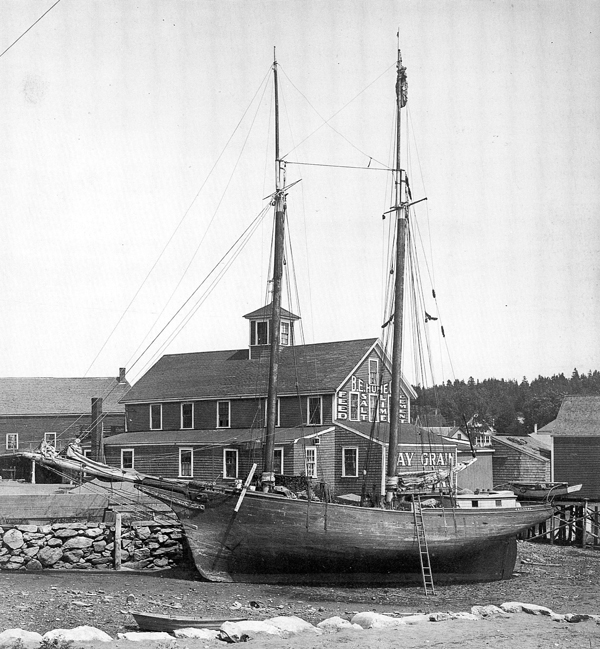B A C K T H E N
The Packet Railroad

The packet schooner Railroad at Boothbay Harbor, early 1900s. Her booms swung over the wharf list her inboard. The slippery little schooner was built at Castine in 1872, possibly as a fisherman. Later, in league with the schooner Good Templar, she delivered dried fish from islands and small outposts to the Trefethen’s extensive fish-processing establishment at House Island, Portland. She served as a packet from Deer Isle, and later ran for years as a packet between Boothbay Harbor and Portland, delivering stock for Hume’s store. Lying just inside the harbor footbridge, she grounded out at every tide.
Strictly speaking, a “packet” plied between specific ports, carrying passengers and merchandise, under a schedule, but considerable leeway was eventually permitted in the application of the term. Pre-Civil War Boston was the center of a great packet trade from Cape Cod and Down East. T Wharf was virtual Maine territory. Captains of leading packets were bold, skillful pilots, and important men in their communities commonly entrusted with large sums of bank notes. Among the champions of the fleet, with paneled cabins, were packets hailing from Eastport. Passengers sometimes included groups of giddy farm girls, headed for the cottonmills of Lowell, who sang as they helped with the cabin chores. Less cheerful were families abandoning thin-soiled homesteads, and seeking a new start in Ohio, via the Erie Canal. A Captain Skinner, who ran a Belfast-Castine packet in the early 1800s, crossed the bay 30,000 times in the course of thirty years, very conservatively calculated to have equaled fourteen circumnavigations.
A fleet of eight schooners maintained packet service between Augusta and Boston alone. Waterville packets had hinged masts to allow passage under the Augusta bridge. When the railroad came to Waldoboro in the ‘70s, the town’s fleet of a dozen or so packets was reduced to one. Bangor packets in the ‘70s and the ‘80s included the Mary Willey, which often brought corn from Portland; the smart little centerboarder Louella; and the roly-poly Magnum Bonum, Captain Turner, of Newburyport, which showed up every fall with Baldwin apples, cabbages, and onions. The Boston packets, including the Abbie S. Oakes, J. P. Merriam, M.L. Crockett, Mary A. Heyer, Koret, and the Mazurka, made a gallant stand against railroad and steamer competition, carrying much general merchandise. (In the spring it was customary for Ellsworth packets to deliver cargoes of bean poles to Boston.)
Although some packet schooner service to Boston would continue into the ‘90s, in the ‘80s Widgery’s Wharf at Portland, Tillson’s Wharf at Rockland, and Belfast had become the centers of eastern packet operations. All of these were railhead ports.
In 1885 the schooner Portland Packet, boasting a high fly rail, a tall rig, and passenger accommodations in the cabin, was built to provide service between Portland and railroadless Eastport, Lubec, and Pembroke. The peak of the Portland packet business occurred about 1890. Common cargoes were kerosene (and later, gasoline), oil, lumber, grain, rigging, small freight, and general store stock including everything from “a sheet of flypaper to a clap of thunder.” (The last item may refer to explosives, which, along with flammable liquids, were not permitted on passenger-carrying steamers.) Rates were low, and special delivery could be arranged to the isolated cove. Captains, who were often the owners, regularly shopped for customers back home. Crew members, frequently hired at either end of the trip, often pumped for transportation. The fifty or more latter-day packets sailing from Portland (some were “tramps”) included the Railroad, E.T. Hamor, Annie F. Kimball, Lizzie Clark, Lydia Grant, Gold Hunter, Ralph K. Grant, J.S. Glover, William Keene, Enterprise, Billings Brothers, Hattie Loring, and the Mercantile.
Packets served isolated communities, particularly those on islands and—like Boothbay Harbor and Castine—at the ends of peninsulas. Passengers were carried—some people never overcame their fear of exploding boilers.
Latter day packets were a motley group, and included the 1834 pinky Metamora, moderate of draft and sharp of stern, and the 1855 Grey Hound, shoal of draft and broad of stern. The Grey Hound, evidently christened in sarcasm, sailed, after a fashion, between Vinalhaven and Rockland in the ‘60s, and later, between North Haven and Rockland. A “poor footer,” she also “drifted badly,” once taking five days to make the ten-mile sail across the bay, by way of Matinicus.
The most famous packet touching at Boothbay Harbor was the schooner Eifort, an old Boston pilot schooner that for more than twenty years served as the Monhegan Island packet.
Text by William H. Bunting from A Days Work, A Sampler of Historic Maine Photographs, 1860–1920, Part II. Published by Tilbury House Publishers, 12 Starr St., Thomaston, Maine. 800-582-1899.
